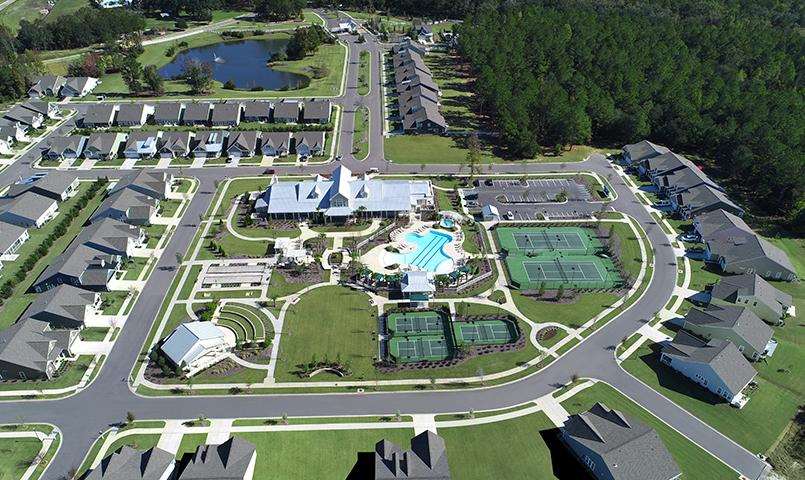by Robert Borges on September 23, 2025
The entire state of South Carolina is subject to hurricanes, but the coast is the most vulnerable. Because Summerville is about forty minutes inland, the town is more protected than areas like Charleston, which sits along the shoreline.
However, hurricanes can bring storm surges, flooding, strong winds, tornadoes, and rip currents. If a hurricane comes to South Carolina, Summerville will most likely be impacted by strong winds, whereas Charleston is likely to experience all five potential impacts.
It’s perfectly reasonable to ask about hurricanes when considering a move to a fifty-five-plus community in Summerville, South Carolina. Determining a storm’s path and if it will head toward South Carolina depends on where it originates, the time of the year, and a variety of other weather conditions.
The good news is that if you visit the South Carolina Emergency Management Division (SCEMD) website and locate Summerville on its map, you will discover that the town is outside the evacuation zones established by SCEMD. You can even plug in your exact address to get more specific information about the risk of storms in your neighborhood.
Understanding Windstorms
A risk assessment issued by First Street Technology stated there is only a 1% chance of a severe windstorm with gusts up to 124 miles per hour occurring in Summerville in the next thirty years.
Wind speeds associated with each category of hurricane and storm are:
- Tropical storm: Thirty-nine to seventy-four MPH
- Category 1: Seventy-four to ninety-five MPH
- Category 2: Ninety-six to 110 MPH
- Category 3: 111 to 129 MPH
- Category 4: 130 to 156 MPH
- Category 5: 157 MPH or higher
Summerville Hurricaine History
Summerville is known for many things, and while it's not a hotspot for direct hurricane strikes, it is not entirely free from risk. The town is more likely to face complications from heavy rain, flooding, or tropical-storm–level winds when a hurricane or tropical system passes nearby. Still, its inland location greatly reduces the odds of catastrophic storm surge or the full brunt of a major hurricane hitting. The historical record supports that direct, powerful hurricane landfalls are rare for South Carolina—and even rarer in towns situated so far from the coastline.
Historical Hurricane / Tropical Cyclone Activity
At the state level, from 1851 to 2023, 44 tropical cyclones have made landfall along the South Carolina coast, but only a few of those did so as major hurricanes (Category 3 or higher) — notably Hazel (1954), Gracie (1959), and Hugo (1989). No Category 5 hurricane has ever been recorded making landfall in South Carolina.
When powerful storms like Hurricane Hugo in 1989 pushed inland, they delivered damaging winds and rainfall far beyond the immediate coast, but their force tends to weaken over distance and terrain.
In more recent events, instead of full hurricanes, Summerville is more likely to be affected by the leftovers or peripheral impacts of tropical storms or depressions. For example, in October 2015, flooding associated with Hurricane Joaquin’s moisture stalled over the region produced exceptional rainfall in the Carolinas, though the storm itself did not make a direct hit.
Key Vulnerabilities & Mitigating Factors
-
Flooding / Rain Impacts: Because rain bands can extend far inland, flooding and flash flood risk is a major concern even when a storm’s center remains distant.
-
Wind & Tree Damage: Even tropical-storm strength winds can down trees or power lines, especially in heavily wooded or poorly maintained areas.
-
Storm Surge: This is largely a non-risk for Summerville itself, as it lies well above zones affected by storm surge.
-
Distance Damping: Tropical systems generally lose strength as they move inland, and Summerville’s inland position gives it a buffer against the full fury of a hurricane’s core.
-
Local Topography & Drainage: Local elevation, floodplain mapping, and stormwater infrastructure influence how much impact a given storm might have in a particular neighborhood.
Protecting Against the Impact of Hurricanes
Strong winds can knock down trees and blow around debris. However, new planned adult communities such as Horizons at Summers Corner are built according to the latest construction codes, often including building specifications that reduce the chance of damage from storms.
If a storm is heading your way, do your part to stay safe. Bring trash cans and lawn furniture inside and secure gas grills and other items that are unsafe to bring indoors. If your area is prone to flooding, move to higher ground before the storm arrives.
During a hurricane or strong storm, stay inside and stay away from windows, glass doors, and skylights. Household items can become dangerous projectiles during high winds, so it's better to stay in the center of your home with as many walls as possible between you and Mother Nature. If you have a generator, make sure it is grounded and only operate it outside (not in a garage or basement).
Discover Summerville

Hurricane season in South Carolina runs from June 1st to November 30th, with September being the most active month. However, the number of hurricanes that impact the Palmetto State is far less than Florida, Texas, and Louisiana.
In addition to the cost of living in Summerville being far more reasonable than in other parts of the country, the weather is warm most of the year–making it a wonderful place to live and enjoy outdoor activities. It can get chilly in the winter (hovering around forty degrees) and inch up near ninety degrees in the summer, but there are plenty of days of wonderful weather.
Private Communities Registry (PCR) has amenity-rich, master-planned lifestyle communities in Summerville, including K. Hovnanian’s Four Seasons at Lakes of Cane Bay, and Horizons at Summers Corner and Summers Corner, both by Lennar. Both builders are large, nationally recognized construction companies with years of experience delivering quality homes.
PCR makes researching for a new home as easy as pie with in-depth profiles of single-family and active adult living communities. Our intuitive platform allows you to search according to price range, location, style of home, and the amenities that mean most to you!
